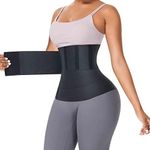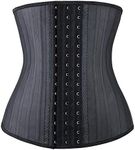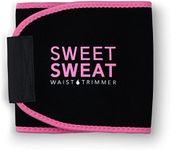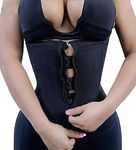Buying Guide for the Best Waist Trainers
Waist trainers are garments designed to cinch the waist and create an hourglass figure. They are often used for aesthetic purposes, posture support, or as part of a fitness routine. When choosing a waist trainer, it's important to consider your goals, comfort, and the level of support you need. Understanding the key specifications will help you select a waist trainer that best fits your body and lifestyle.MaterialThe material of a waist trainer is crucial for comfort, durability, and effectiveness. Common materials include latex, cotton, and neoprene. Latex is popular for its elasticity and firm compression, making it ideal for those seeking significant waist reduction. Cotton is softer and more breathable, suitable for everyday wear. Neoprene is often used in fitness waist trainers for its heat retention properties, which can enhance sweating during workouts. Choose a material based on your comfort preference and intended use.
SizeSize is one of the most important factors when selecting a waist trainer. A properly fitting waist trainer should be snug but not overly tight, allowing you to breathe comfortably. Sizes typically range from small to extra-large, and some brands offer plus sizes. To find the right size, measure your waist at its narrowest point and refer to the brand's sizing chart. If you're between sizes, consider your comfort level and whether you plan to wear it for extended periods.
Compression LevelCompression level refers to how tightly the waist trainer fits around your waist. High compression waist trainers offer more dramatic shaping and are often used for special occasions or short-term wear. Medium compression provides a balance between comfort and shaping, suitable for daily wear. Low compression is more comfortable and less restrictive, ideal for beginners or those prioritizing comfort. Your choice should depend on your comfort tolerance and the level of shaping you desire.
Closure TypeThe closure type affects the ease of use and adjustability of the waist trainer. Common closure types include hook-and-eye, zipper, and Velcro. Hook-and-eye closures offer multiple adjustment levels, allowing for a more customized fit. Zippers provide a sleek look and are easy to put on and take off. Velcro closures are highly adjustable and convenient, often found in fitness waist trainers. Consider how often you'll be adjusting the fit and your preference for ease of use when choosing a closure type.
LengthThe length of a waist trainer determines how much of your torso it covers. Short waist trainers cover the waist area only, providing more freedom of movement and comfort for shorter torsos. Long waist trainers extend to the hips or under the bust, offering more coverage and support, which can be beneficial for posture correction. Choose a length based on your torso size and the level of coverage you desire.














